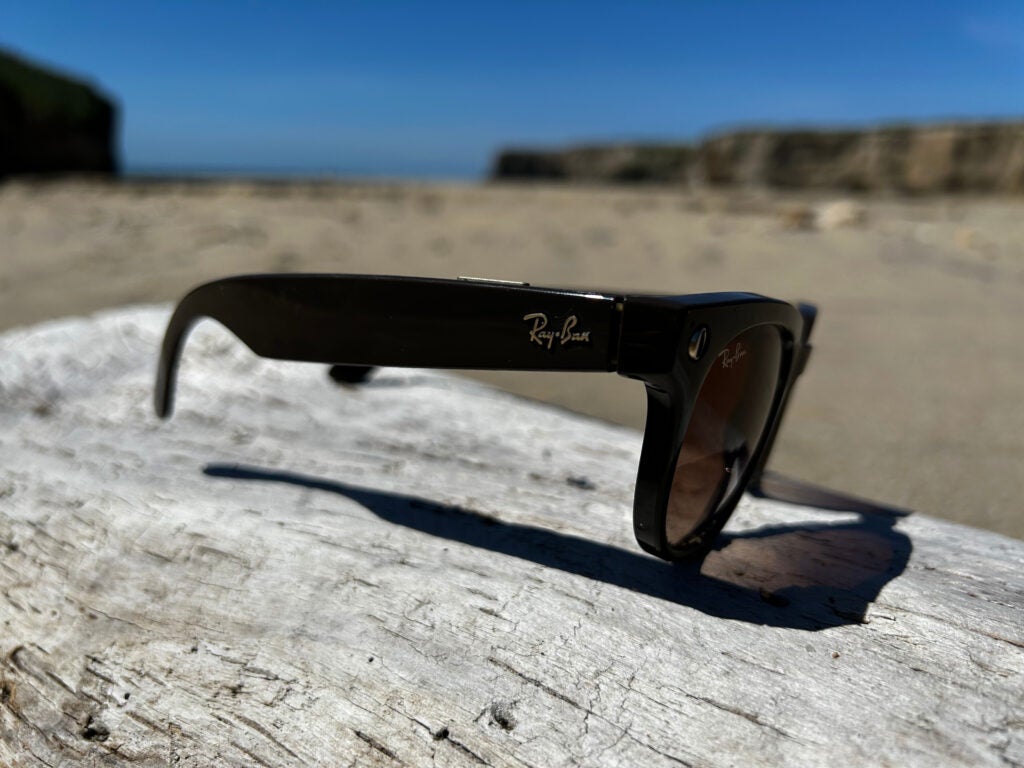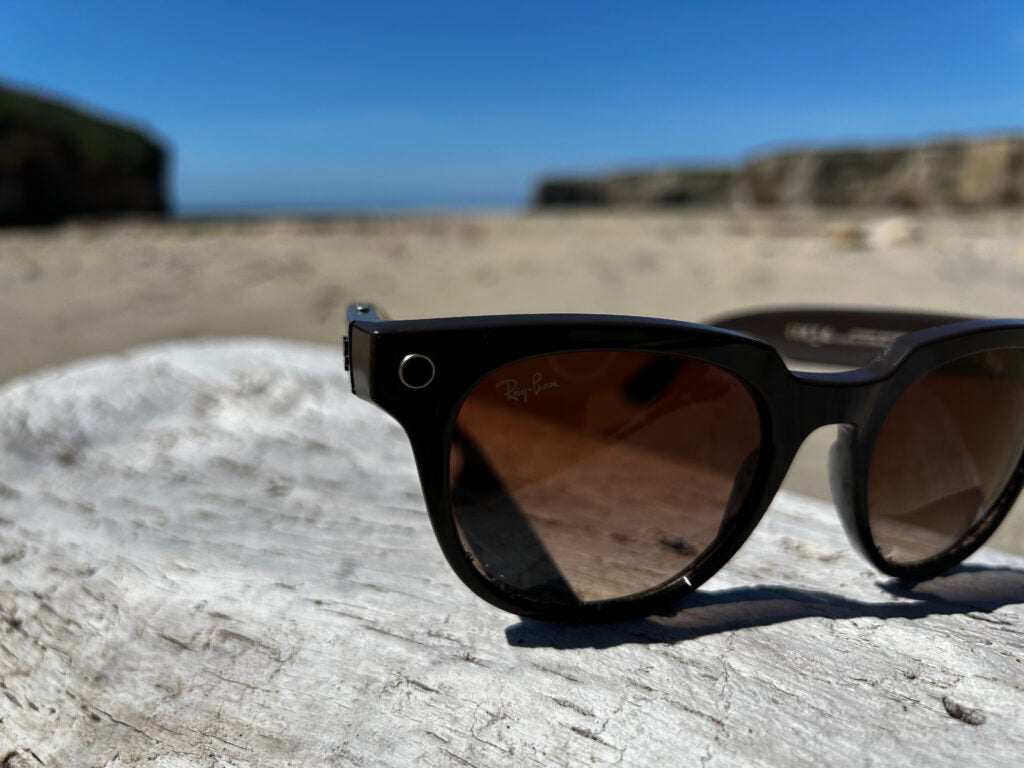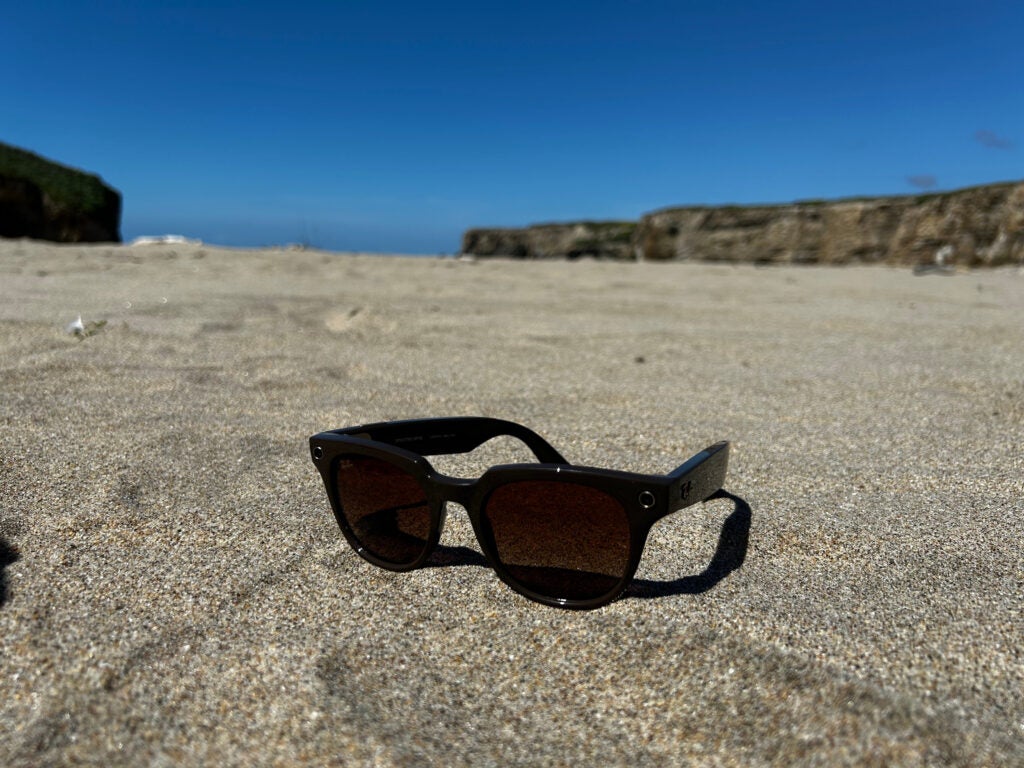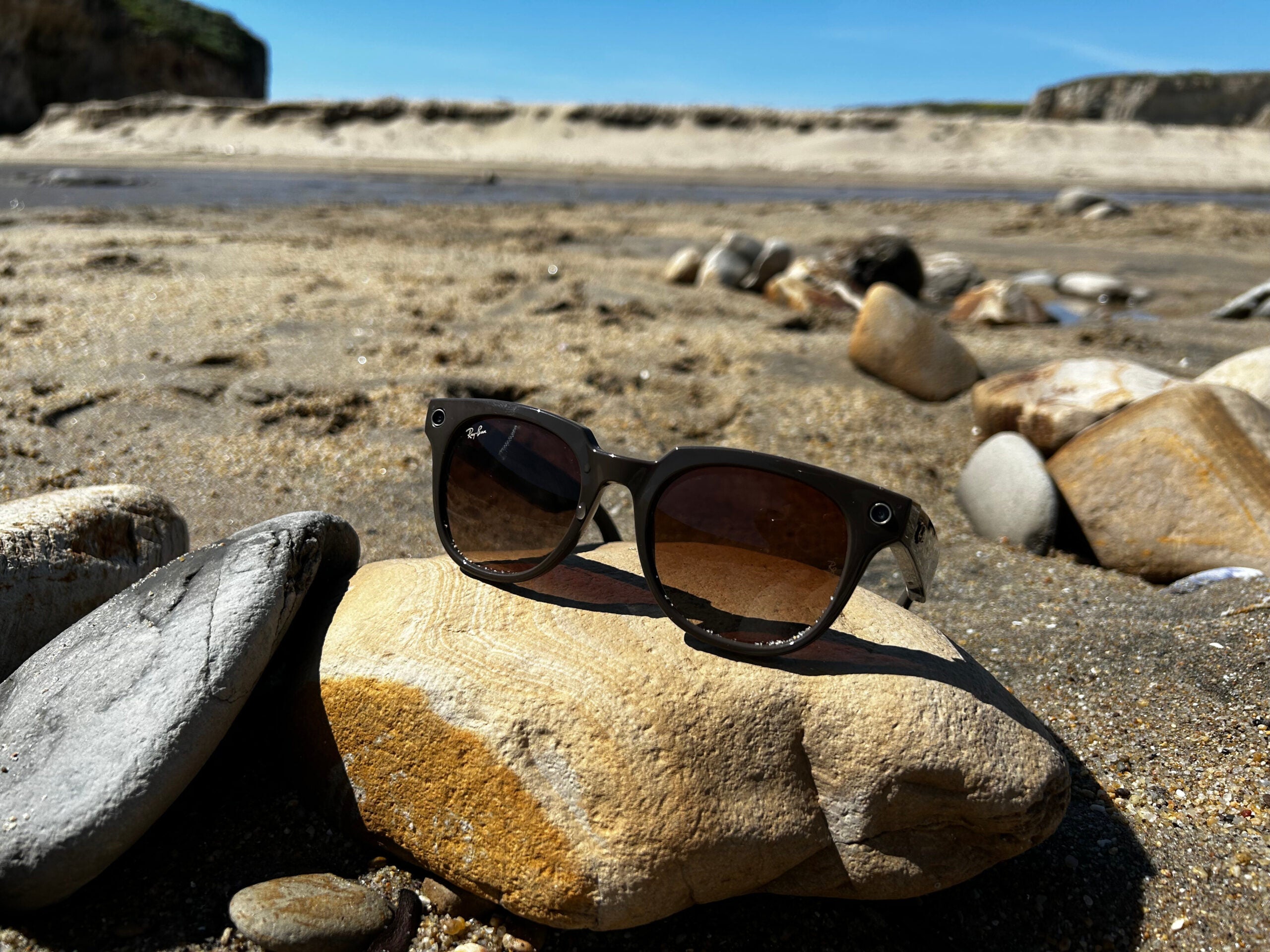Verdict
The Ray-Ban Stories are camera-toting smartglasses that really do look like a lovely pair of shades and are capable of capturing your adventures in a more memorable way. Ultimately though, they don’t have the hardware to deliver the standout performance to match that attractive, designer look and also doesn’t always make it obvious to those around you that you’re in recording or shooting mode.
Pros
- Look and feel like normal Ray-Ban glasses
- Easy to use
- Good charging case
Cons
- Takes time to get good quality images and video
- Not water resistant
- Hats and hair can get in the way of cameras
Availability
- UKRRP: £299.99
- USARRP: $299
-
Shoots video and takes photos:All without your smartphone -
Voice control for hands-free use:Use voice commands to shoot content -
Three microphones to take calls and capture audio:You can also listen to music via speakers
Introduction
The Ray-Ban Stories are smartglasses built in collaboration with Meta, letting you take photos, record video and listen to your music without reaching for your phone or a pair of headphones.
Like the Snapchat Spectacles, Meta and Ray-Ban’s parent group Essilor Luxottica has set its sights on making connected specs that feel just like wearing a normal pair of sunglasses. They’re modelled on existing designs to give it that more familiar and stylish look.
Those extra smarts make picking up a pair of connected Ray-Bans an even pricier investment, so do they perform well enough to justify that extra spend? I decided to put my phone and headphones to one side to see if these smartglasses could help me forget about them.
Design and build
- Comes in three familiar Ray-Ban designs
- Available in large size only
- Not water resistant
Glasses packed with cameras, speakers and microphones aren’t a new phenomenon, but the pairs that work best are the ones where you don’t feel the presence of that extra hardware. Thankfully, that isn’t the case with these smart sunglasses.

These feel like a pretty regular pair of Ray-Bans. The weight difference between a smart and non-smart pair is around 5g and typically, that added hardware means bulking up the frames but that isn’t the case with the Stories.
That’s helped by the fact that they’re offered in three distinct looks, all with multiple colour options that are closely modelled on existing designs. There’s the iconic Wayfarer, a Round version and the Meteor look that I had to live with and, slight added weight aside, I never felt like I was wearing a bulky, tech-filled pair of specs.
All of the designs come in a large size option, which didn’t feel too big to me with all of them also offering a high bridge fit to make sure that your eyes sit in the proper position behind the lenses. Speaking of lenses, you do have the option to add in prescription ones in here as well, just in case you’re hoping they can replace your regular glasses or give you a contact lens break when conditions get sunnier.
The key feature here are the dual, five-megapixel cameras that sit in the corner of each lens, with a small white LED light just beside each of them to let people know around you that recording or snapping is in progress. Unlike Snap’s Specs, those cameras do seem to sit a little less prominently here, while that indicator light isn’t hugely visible when using them in bright outdoor light either, which does raise some questions on just how obvious they make it to others that you’re recording and shooting.

There’s a solitary, long physical button on the top of the right arm to act as your camera shutter with an on/off slider switch positioned on the inside of the glasses with an LED light on the opposite side to tell you when they’re ready to snap away and whether they’re connected to your phone to do things like stream music or take calls.
Unlike a normal pair of glasses, you won’t want to dunk them in water. They don’t carry any sort of water resistance rating and while I did try to get creative with them in some water and they did survive, we don’t recommend trying this yourself.
When they’re not in use there’s quite a big charging case to make use of, where the glasses have to be placed precisely in-line with the charging port hidden away inside of the hinge of the glasses frame. That case does hold its own charge too, with a charging status indicator light at the front and a USB-C charging port around back when you need to power the case and glasses back up. Like the glasses, it doesn’t carry any sort of waterproofing, but it does feel like it offers up good protection for the specs.
Features and performance
- Shoots five-megapixel quality images
- Records 1184 x 1184 resolution video at 30fps
- Onboard voice and touch controls
What these glasses are primarily designed to do is to replace pulling out your phone to take photos and record video. Yes, they can let you listen to music and handle calls as well, but the true appeal is in having a readily available camera on your face.
So how good a job does it do on that front? I’d say that it does a good job, but performance certainly doesn’t blow you away and you really need to master the best way to shoot, as well as find the best lighting conditions to get the most rewarding results.

Once you’ve gone through a pretty painless set-up process with the Facebook View companion smartphone app, which does require a Facebook account, you can open up the glasses and you’ll hear a voice prompt telling you the battery level in percentage, before needing to wait for a beeping sound to tell you that you’re ready to shoot.
Then it’s a simple case of pressing the physical shutter button to record video or holding it down to take a photo. There are also voice controls, letting you say, ‘Hey Facebook’ to tell them to take a photo, record a video or alternatively take control of music playback and handle a call.

When you’re recording video, you’re capturing 1184 x 1184 resolution video at 30fps with a maximum duration of 60 seconds. For pictures, those are snapped at a 2592 x 1984 pixel resolution. So on paper, not quite the same level of video quality promised by Snap on its latest Spectacles, but something potentially a little better on the image front. The camera on the left side of the glasses is used for something called stereo depth estimation. It combines with the images taken with the right camera to add effects and filters to leverage photo depth and create a sort of 3D-style effect.
Ultimately, the video and photo capturing abilities of the Stories are good, particularly with imagery in the right kind of natural lighting conditions, but it’s definitely been a tad hit and miss with the video quality. A lot of the video I shot wasn’t always particularly sharp or vivid, and the colours at times felt saturated. When you add movement into the equation, it handles things relatively well but it can result in juddering if you move quickly whilst wearing them.

Something that did stand out was the audio capture, with the Stories packing in three microphones that do a very good job of grabbing exterior sound and voices, and also make them useful for calls too. They were very sensitive to picking up the sound of wind however, which didn’t sound great on videos.
As audio glasses, they aren’t particularly great or better than what you will get from dedicated audio glasses already out there. They have a great deal of sound leakage too, so people will be able to hear what you’re listening to. The touch controls also built into the frames do take a bit of time to get used to, particularly in finding the sweet spot to quickly play and pause audio.
There’s also the challenge of shooting from glasses and thinking differently about how you’ll get the most rewarding pics and videos. Trying to take photos or video of someone walking alongside you isn’t very easy to do unless they’re standing a little further away than usual. You don’t want to wear them with a cap either as I found that you’ll end up with footage that’s partially obstructed by your cap’s brim, which isn’t exactly ideal. It’s the same situation with hair. It can be all too easy to accidentally take photos and videos as well, which will eat into your storage with no way to delete them directly from the glasses.
There’s no doubt that the Ray-Ban Stories can offer a refreshingly different perspective and an alternative means to pointing and shooting with a camera or a phone, but it takes some playing around to get the best footage or shots in the optimal scenarios and conditions. By the end of a day’s shooting I ended up with a mixed bag of photos and videos and that’s really the problem here. You have to shoot a lot to increase your chances of getting something that really beats what you’re getting from your phone.

App and battery life
- Works with Android and iOS
- Requires a Facebook account
- Up to 3 hours of battery life
When you record or shoot photos with the Stories, those files are stored on the built-in 4GB of storage which should give you room for over 500 photos or over 15, 60-second videos. The glasses will fire out a voice prompt when you’re closing in on that storage capacity and when you’ve maxed it out as well.
For a day of testing, I took a mixture of 73 images and videos and managed to fill up that promised 4GB of storage. You can’t view any of those captured stills or footage on the glasses themselves so you need to sync them all over to the Facebook View app which can be a little slow going if you’re syncing over a lot of stuff at once. Once it’s all synced over, it’s wiped from the glasses to give you more room to shoot again.
The Facebook View app gives you a sort of thumbnail-style grid to look over captured footage and images, and will create highlight montages which don’t exactly rival how Apple or Google’s own photo apps manage to blend imagery and videos into one.
There’s a Flashback mode to create 3D videos and also scope to tinker with features like video length capture, setting up Spotify integration for music playback and setting up calling and messaging support as well. There’s some pretty basic editing tools here too like the ability to trim videos and adjust image brightness, saturation, sharpness and warmth, and it’s these features that will help you get the most of the raw images.
On the battery front, up to three-hours is quoted but that really depends on whether you’re shooting more video than images and you’re using the glasses for music streaming as well. I think that if you want to use them for an entire day, then you’ll need to do so sparingly. After around three hours of pretty regular use, with a focus on video over photo capture, the battery dropped by 50%. The best way to keep that battery going is to switch them off when you’re not using them for a period as they don’t automatically turn themselves off when not in use.

Latest deals
Should you buy it?
You want a really nice-looking pair of camera sunglasses: If you’re sold on the idea of having cameras in your glasses, these are arguably the best-looking pair that do just look like a nice pair of Ray-Ban glasses.
You want smartphone camera-rivalling video and pics: While it might be more convenient to take pictures from your glasses, the image and video quality simply doesn’t match what your camera phone can already do.
Final Thoughts
The Ray-Ban Stories really feel like a bit of a missed opportunity for both Ray-Ban and Meta. They got one part right, which was to make the tech mostly disappear inside of a very stylish pair of sunglasses. I did manage to capture some memorable videos from a unique perspective that I would’ve struggled to get from a phone, but if you’re hoping for smartphone-rivalling quality overall, these glasses aren’t quite there yet. To see what other products you can pair with your smartphone, you can check out our round-up of the best iPhone accessories.
How we test
Unlike other sites, we thoroughly test every product we review. We use industry standard tests in order to compare features properly. We’ll always tell you what we find. We never, ever accept money to review a product.
Tested over several weeks
FAQs
No, the Ray-Ban Stories sunglasses or charging case are not waterproof and not suitable for being submerged in water for activities like swimming.
Yes, you can share images to your phone’s camera app or camera roll and to some supported third party apps as well.
Sustainability
TrustedReviews’ holds the fact that global warming is not a myth as a core value and will continuously endeavour to help protect our planet from harm in its business practices.
As part of this mission, whenever we review a product we send the company a series of questions to help us gauge and make transparent the impact the device has on the environment.
We currently haven’t received answers to the questions on this product, but will update this page the moment we do. You can see a detailed breakdown of the questions we ask and why in our sustainability info page.
Verdict
The Ray-Ban Stories are camera-toting smartglasses that really do look like a lovely pair of shades and are capable of capturing your adventures in a more memorable way. Ultimately though, they don’t have the hardware to deliver the standout performance to match that attractive, designer look and also doesn’t always make it obvious to those around you that you’re in recording or shooting mode.
Pros
- Look and feel like normal Ray-Ban glasses
- Easy to use
- Good charging case
Cons
- Takes time to get good quality images and video
- Not water resistant
- Hats and hair can get in the way of cameras
Availability
- UKRRP: £299.99
- USARRP: $299
-
Shoots video and takes photos:All without your smartphone -
Voice control for hands-free use:Use voice commands to shoot content -
Three microphones to take calls and capture audio:You can also listen to music via speakers
Introduction
The Ray-Ban Stories are smartglasses built in collaboration with Meta, letting you take photos, record video and listen to your music without reaching for your phone or a pair of headphones.
Like the Snapchat Spectacles, Meta and Ray-Ban’s parent group Essilor Luxottica has set its sights on making connected specs that feel just like wearing a normal pair of sunglasses. They’re modelled on existing designs to give it that more familiar and stylish look.
Those extra smarts make picking up a pair of connected Ray-Bans an even pricier investment, so do they perform well enough to justify that extra spend? I decided to put my phone and headphones to one side to see if these smartglasses could help me forget about them.
Design and build
- Comes in three familiar Ray-Ban designs
- Available in large size only
- Not water resistant
Glasses packed with cameras, speakers and microphones aren’t a new phenomenon, but the pairs that work best are the ones where you don’t feel the presence of that extra hardware. Thankfully, that isn’t the case with these smart sunglasses.

These feel like a pretty regular pair of Ray-Bans. The weight difference between a smart and non-smart pair is around 5g and typically, that added hardware means bulking up the frames but that isn’t the case with the Stories.
That’s helped by the fact that they’re offered in three distinct looks, all with multiple colour options that are closely modelled on existing designs. There’s the iconic Wayfarer, a Round version and the Meteor look that I had to live with and, slight added weight aside, I never felt like I was wearing a bulky, tech-filled pair of specs.
All of the designs come in a large size option, which didn’t feel too big to me with all of them also offering a high bridge fit to make sure that your eyes sit in the proper position behind the lenses. Speaking of lenses, you do have the option to add in prescription ones in here as well, just in case you’re hoping they can replace your regular glasses or give you a contact lens break when conditions get sunnier.
The key feature here are the dual, five-megapixel cameras that sit in the corner of each lens, with a small white LED light just beside each of them to let people know around you that recording or snapping is in progress. Unlike Snap’s Specs, those cameras do seem to sit a little less prominently here, while that indicator light isn’t hugely visible when using them in bright outdoor light either, which does raise some questions on just how obvious they make it to others that you’re recording and shooting.

There’s a solitary, long physical button on the top of the right arm to act as your camera shutter with an on/off slider switch positioned on the inside of the glasses with an LED light on the opposite side to tell you when they’re ready to snap away and whether they’re connected to your phone to do things like stream music or take calls.
Unlike a normal pair of glasses, you won’t want to dunk them in water. They don’t carry any sort of water resistance rating and while I did try to get creative with them in some water and they did survive, we don’t recommend trying this yourself.
When they’re not in use there’s quite a big charging case to make use of, where the glasses have to be placed precisely in-line with the charging port hidden away inside of the hinge of the glasses frame. That case does hold its own charge too, with a charging status indicator light at the front and a USB-C charging port around back when you need to power the case and glasses back up. Like the glasses, it doesn’t carry any sort of waterproofing, but it does feel like it offers up good protection for the specs.
Features and performance
- Shoots five-megapixel quality images
- Records 1184 x 1184 resolution video at 30fps
- Onboard voice and touch controls
What these glasses are primarily designed to do is to replace pulling out your phone to take photos and record video. Yes, they can let you listen to music and handle calls as well, but the true appeal is in having a readily available camera on your face.
So how good a job does it do on that front? I’d say that it does a good job, but performance certainly doesn’t blow you away and you really need to master the best way to shoot, as well as find the best lighting conditions to get the most rewarding results.

Once you’ve gone through a pretty painless set-up process with the Facebook View companion smartphone app, which does require a Facebook account, you can open up the glasses and you’ll hear a voice prompt telling you the battery level in percentage, before needing to wait for a beeping sound to tell you that you’re ready to shoot.
Then it’s a simple case of pressing the physical shutter button to record video or holding it down to take a photo. There are also voice controls, letting you say, ‘Hey Facebook’ to tell them to take a photo, record a video or alternatively take control of music playback and handle a call.

When you’re recording video, you’re capturing 1184 x 1184 resolution video at 30fps with a maximum duration of 60 seconds. For pictures, those are snapped at a 2592 x 1984 pixel resolution. So on paper, not quite the same level of video quality promised by Snap on its latest Spectacles, but something potentially a little better on the image front. The camera on the left side of the glasses is used for something called stereo depth estimation. It combines with the images taken with the right camera to add effects and filters to leverage photo depth and create a sort of 3D-style effect.
Ultimately, the video and photo capturing abilities of the Stories are good, particularly with imagery in the right kind of natural lighting conditions, but it’s definitely been a tad hit and miss with the video quality. A lot of the video I shot wasn’t always particularly sharp or vivid, and the colours at times felt saturated. When you add movement into the equation, it handles things relatively well but it can result in juddering if you move quickly whilst wearing them.

Something that did stand out was the audio capture, with the Stories packing in three microphones that do a very good job of grabbing exterior sound and voices, and also make them useful for calls too. They were very sensitive to picking up the sound of wind however, which didn’t sound great on videos.
As audio glasses, they aren’t particularly great or better than what you will get from dedicated audio glasses already out there. They have a great deal of sound leakage too, so people will be able to hear what you’re listening to. The touch controls also built into the frames do take a bit of time to get used to, particularly in finding the sweet spot to quickly play and pause audio.
There’s also the challenge of shooting from glasses and thinking differently about how you’ll get the most rewarding pics and videos. Trying to take photos or video of someone walking alongside you isn’t very easy to do unless they’re standing a little further away than usual. You don’t want to wear them with a cap either as I found that you’ll end up with footage that’s partially obstructed by your cap’s brim, which isn’t exactly ideal. It’s the same situation with hair. It can be all too easy to accidentally take photos and videos as well, which will eat into your storage with no way to delete them directly from the glasses.
There’s no doubt that the Ray-Ban Stories can offer a refreshingly different perspective and an alternative means to pointing and shooting with a camera or a phone, but it takes some playing around to get the best footage or shots in the optimal scenarios and conditions. By the end of a day’s shooting I ended up with a mixed bag of photos and videos and that’s really the problem here. You have to shoot a lot to increase your chances of getting something that really beats what you’re getting from your phone.

App and battery life
- Works with Android and iOS
- Requires a Facebook account
- Up to 3 hours of battery life
When you record or shoot photos with the Stories, those files are stored on the built-in 4GB of storage which should give you room for over 500 photos or over 15, 60-second videos. The glasses will fire out a voice prompt when you’re closing in on that storage capacity and when you’ve maxed it out as well.
For a day of testing, I took a mixture of 73 images and videos and managed to fill up that promised 4GB of storage. You can’t view any of those captured stills or footage on the glasses themselves so you need to sync them all over to the Facebook View app which can be a little slow going if you’re syncing over a lot of stuff at once. Once it’s all synced over, it’s wiped from the glasses to give you more room to shoot again.
The Facebook View app gives you a sort of thumbnail-style grid to look over captured footage and images, and will create highlight montages which don’t exactly rival how Apple or Google’s own photo apps manage to blend imagery and videos into one.
There’s a Flashback mode to create 3D videos and also scope to tinker with features like video length capture, setting up Spotify integration for music playback and setting up calling and messaging support as well. There’s some pretty basic editing tools here too like the ability to trim videos and adjust image brightness, saturation, sharpness and warmth, and it’s these features that will help you get the most of the raw images.
On the battery front, up to three-hours is quoted but that really depends on whether you’re shooting more video than images and you’re using the glasses for music streaming as well. I think that if you want to use them for an entire day, then you’ll need to do so sparingly. After around three hours of pretty regular use, with a focus on video over photo capture, the battery dropped by 50%. The best way to keep that battery going is to switch them off when you’re not using them for a period as they don’t automatically turn themselves off when not in use.

Latest deals
Should you buy it?
You want a really nice-looking pair of camera sunglasses: If you’re sold on the idea of having cameras in your glasses, these are arguably the best-looking pair that do just look like a nice pair of Ray-Ban glasses.
You want smartphone camera-rivalling video and pics: While it might be more convenient to take pictures from your glasses, the image and video quality simply doesn’t match what your camera phone can already do.
Final Thoughts
The Ray-Ban Stories really feel like a bit of a missed opportunity for both Ray-Ban and Meta. They got one part right, which was to make the tech mostly disappear inside of a very stylish pair of sunglasses. I did manage to capture some memorable videos from a unique perspective that I would’ve struggled to get from a phone, but if you’re hoping for smartphone-rivalling quality overall, these glasses aren’t quite there yet. To see what other products you can pair with your smartphone, you can check out our round-up of the best iPhone accessories.
How we test
Unlike other sites, we thoroughly test every product we review. We use industry standard tests in order to compare features properly. We’ll always tell you what we find. We never, ever accept money to review a product.
Tested over several weeks
FAQs
No, the Ray-Ban Stories sunglasses or charging case are not waterproof and not suitable for being submerged in water for activities like swimming.
Yes, you can share images to your phone’s camera app or camera roll and to some supported third party apps as well.
Sustainability
TrustedReviews’ holds the fact that global warming is not a myth as a core value and will continuously endeavour to help protect our planet from harm in its business practices.
As part of this mission, whenever we review a product we send the company a series of questions to help us gauge and make transparent the impact the device has on the environment.
We currently haven’t received answers to the questions on this product, but will update this page the moment we do. You can see a detailed breakdown of the questions we ask and why in our sustainability info page.
























